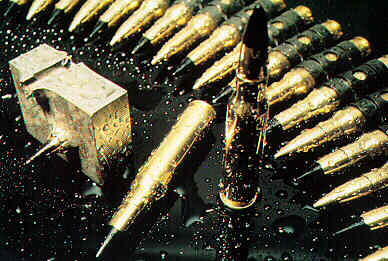IronsightSniper
Junior Member
Following up on my post, the latest vest the Army uses (at least limitedly) is the SPCS (the Soldier Plate Carrier System). It's essentially a lighter weight IOTV, and has stand-alone protective capabilities against your Mk. 1 shrapnels and 9 mm bullets (not entirely sure about that, but I know the IOTV does at least). Allows for the inserting of 2 plates, front and rear, and to my surprise, I didn't notice the U.S. Army had rolled out a new plate (the XSAPI). The XSAPI plate is 'slightly' heavier than the ESAPI, but is more protective (the info is still secretive, but 'open source documents' state that the XSAPI can shrug off a M993 round which could penetrate an ESAPI). For reference, the various penetration figures I got for it were: 7 mm of High Hardness Armor at 500 m, 16 mm of Rolled Homogenous Armor at 300 m, and this:
 So it's a pretty hot round!
So it's a pretty hot round!
Anywhoot, this new SPCS vest weighs some 2.65 kg for a size medium and a SPCS vest with front and back XSAPI plates along with Side XSAPI plates would weigh 10.63 kg (23.45 lb for us Americans).
This lightweight system is light in comparison to somewhat older (as in, not even a decade ago, we were using these) systems such as the Interceptor Body Armor, which weighed 15 kg (33.1 lb) total.
Of course, if you're curious, that massive weight savings do not come from new technologies, so much as removing additional armoring. The Interceptor Body Armor, in comparison to the "Modular Vest" that our Special Forces use, covers 5.71 sq. m of the body in comparison to the 1.49 sq. m of the body from wearing that modular vest. The Interceptor Body Armor, which, now that I think of it, resembles the intensive armoring practices of European Knights in the Medieval ages, though, it did not take some centuries for the Army to start to phase out overly bulky armoring schemes in preference for lighter ones like the SPCS. In any case, until lighter armoring technologies become realized, this'll be where armoring might stall.
But on the topic though, it seems I am blind. The weight of the Chinese ballistic vest system shown here includes everything it lists (This system consists of two parts, the individual combat comprehensive support system and the individual life comprehensive support system, and serves the functions of defense and protection, self-help and mutual aids, eating and drinking, camping and bivouacking, and many others. Its total weight is only 15 kilograms.) So, it's relatively light, though, it does not make mention specifically of ballistic plates, so that may be where the weight savings come from.

Anywhoot, this new SPCS vest weighs some 2.65 kg for a size medium and a SPCS vest with front and back XSAPI plates along with Side XSAPI plates would weigh 10.63 kg (23.45 lb for us Americans).
This lightweight system is light in comparison to somewhat older (as in, not even a decade ago, we were using these) systems such as the Interceptor Body Armor, which weighed 15 kg (33.1 lb) total.
Of course, if you're curious, that massive weight savings do not come from new technologies, so much as removing additional armoring. The Interceptor Body Armor, in comparison to the "Modular Vest" that our Special Forces use, covers 5.71 sq. m of the body in comparison to the 1.49 sq. m of the body from wearing that modular vest. The Interceptor Body Armor, which, now that I think of it, resembles the intensive armoring practices of European Knights in the Medieval ages, though, it did not take some centuries for the Army to start to phase out overly bulky armoring schemes in preference for lighter ones like the SPCS. In any case, until lighter armoring technologies become realized, this'll be where armoring might stall.
But on the topic though, it seems I am blind. The weight of the Chinese ballistic vest system shown here includes everything it lists (This system consists of two parts, the individual combat comprehensive support system and the individual life comprehensive support system, and serves the functions of defense and protection, self-help and mutual aids, eating and drinking, camping and bivouacking, and many others. Its total weight is only 15 kilograms.) So, it's relatively light, though, it does not make mention specifically of ballistic plates, so that may be where the weight savings come from.



